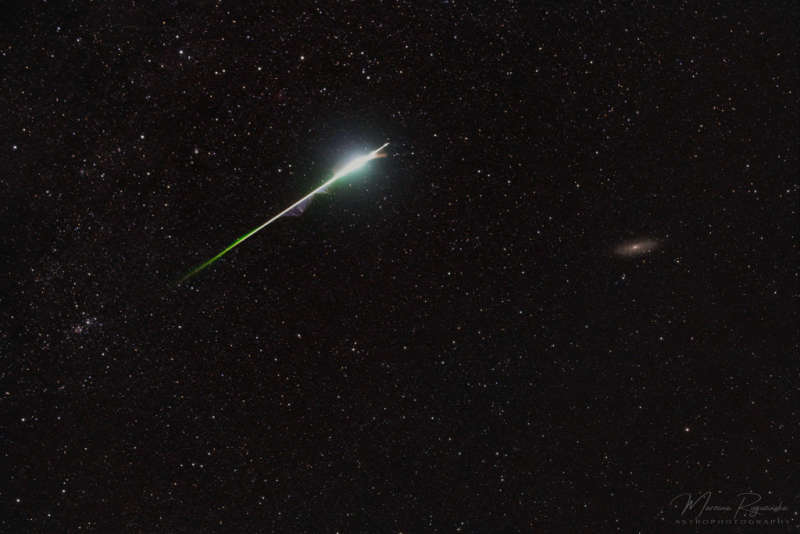Credit & Copyright: Marzena Rogozinska
Explanation:
Stars in our own Milky Way Galaxy are scattered through this
eye-catching field of view.
From the early hours after midnight on August 13,
the 30 second exposure of the night sky over Busko-Zdroj, Poland
records the
colorful and bright trail of a
Perseid
meteor.
Seen near the peak of the
annual
Perseid meteor shower it
flashes from lower left to upper right.
The hurtling grain of cosmic sand, a piece of dust from
periodic comet Swift-Tuttle,
vaporized as it passed through planet Earth's atmosphere
at almost 60 kilometers per second.
Just above and right of center, well beyond the stars of
the Milky Way, lies the island universe
known as M31 or the Andromeda Galaxy.
The Andromeda Galaxy
is the most distant object easily visible to the naked-eye,
about 2.5 million light-years away.
The visible meteor trail begins only about
100 kilometers
above Earth's surface, though.
It points back to the meteor shower radiant
in the constellation Perseus off the lower left edge of the frame.
Follow this bright perseid meteor trail below and left to
the stars of NGC 869and NGC 884, the
double star cluster in Perseus.
Notable APOD Image Submissions:
Perseid
Meteor Shower 2021
1999 2000 2001 2002 2003 2004 2005 2006 2007 2008 2009 2010 2011 2012 2013 2014 2015 2016 2017 2018 2019 2020 2021 2022 2023 2024 2025 |
Январь Февраль Март Апрель Май Июнь Июль Август Сентябрь Октябрь Ноябрь Декабрь |
NASA Web Site Statements, Warnings, and Disclaimers
NASA Official: Jay Norris. Specific rights apply.
A service of: LHEA at NASA / GSFC
& Michigan Tech. U.
|
Публикации с ключевыми словами:
M 31 - Perseids - Персеиды
Публикации со словами: M 31 - Perseids - Персеиды | |
См. также:
Все публикации на ту же тему >> | |
